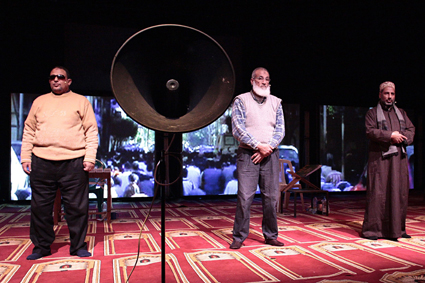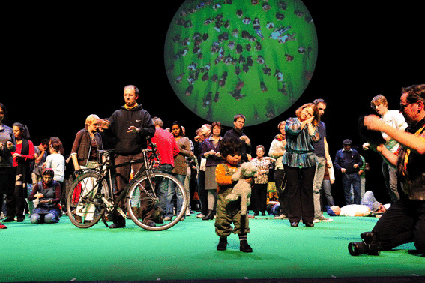experts of the everyday
meg mumford & ulrike garde: rimini protokoll

Radio Muezzin, Rimini Protokoll
photo courtesy Rimini Protokoll
Radio Muezzin, Rimini Protokoll
SITTING IN THE DARK WE EXPERIENCE THE SOUNDS AND VIBRATIONS OF THE AZAN, OR CALL TO PRAYER, SUNG BY THREE MUEZZINS FROM SEPARATE CORNERS OF THE AUDITORIUM. EVENTUALLY EACH SINGER IS REVEALED BY A SPOTLIGHT. THROUGH A MÉLANGE OF INTERMINGLING MELODIES, RHYTHMS AND TEMPI, ABDELMOTY ABDELSAMIA, HUSSEIN GOUD AND MANSOUR ABDELSALAM EVOKE FOR US THE SOUNDSCAPE OF CAIRO.
This is the opening of Radio Muezzin (RT107, p3), a documentary performance directed by Stefan Kaegi of Berlin-based Rimini Protokoll. Since 2000, directors Kaegi, Helgard Haug and Daniel Wetzel have worked in a wide range of collaborative partnerships, producing diverse and acclaimed forms of socially-engaged performance. Through Radio Muezzin, and the upcoming production in May of 100% Melbourne, Australian audiences are able to experience first hand Rimini’s unique version of Reality Theatre. This currently prominent mode of performance engages with the ‘facts’ of social reality, particularly through representing contemporary people. The representations may involve a scripted text based on interviews and documents and/or the literal appearance of the people themselves in real-life sites. What is distinctive about Rimini’s version of Reality Theatre is their replacement of professional actors with people who are specialists in other fields of life. Working with these “experts of the everyday,” Rimini open up live encounters between people unfamiliar with each other within a globalised world.
While the local adaptations of the 100% series offer insights into the seemingly familiar aspects of one’s own city, Radio Muezzin (2008–) allows a glimpse of an Egypt inaccessible to many, one inhabited by four muezzins and a radio engineer, Sayed Abdellatif. Through carefully orchestrated autobiographical stories, the presentation of religious rituals, still images, video footage and soundscape, we gain diverse insights, mainly into the lives of the less visible members of Egypt’s institutionalised Islamic faith. These ‘good souls’ of the mosque introduce us to their daily responsibilities, including housekeeping tasks, and their religious roles as teachers of the Qur’an and callers of the azan.
During the production the audience are made aware that the visibility of these muezzins is likely to be diminished even further, for, as Sayed informs us, the azan in Cairo “will no longer be called from thousands of voices but will be broadcast via radio.” As in other works by Rimini, the homogenising nature of such centralisation processes is a key concern. So too is the related issue of censorship—the withholding of information and the making absent and silencing of citizens that can accompany such centralisation. The theme of silencing is later sounded again when Mohamed Ali, a young socially empowered muezzin who only appears in a highly mediated way (via footage, sound recording and a performer who reads out his text), announces: “[t]o avoid the different voices and times the Ministry [for Religious Affairs] has decided that only one man is to call people to each prayer.” He also declares himself to be one of the 30 trained voices selected to perform this role. These brief and dispersed comments from the engineer and muezzin leave much to the imagination. For example, the reasons for the changes, date of their completion and the economic consequences are never fully fleshed out. Will the men stand to lose their jobs, or ‘only’ their public prayer voice?
As is typical of Rimini’s work, Radio Muezzin rarely presents its political and cultural concerns in a didactic manner. In part this approach stems from sensitivity to the political context and to the personal needs and safety of the experts. In the last section of the performance the production overtly acknowledges the impact of regulatory forces that limited what could be said and shown. During the blind muezzin Hussein Gouda’s rendition of a religious song, statements—presumably from the Ministry—roll silently in Arabic (accompanied by English surtitles) across the streetscape footage on the upstage screen, telling us some of what the authorities saw fit to ban: “On the screens there should be no donkeys or dogs. And also no garbage or actors. Muezzins cannot play dominoes on stage…What can’t be said in the presence of one’s mother, sister, daughter or wife one should not say in front of any woman.”
The muezzin’s function as a role model for the Egyptian citizenry and ambassador for Islamic faith is perhaps one reason why the protagonists’ political opinions and differences are only partially revealed. For example, we learn that Mohamed Ali left the show after coming into conflict with the other muezzins, but the details of the dispute are never divulged. The partial concealment here is one of the ways Rimini work to ensure that the act of making an unfamiliar person visible does not slip into the terrain of dangerous or exploitative spectacle.
Rimini’s interest in ensuring voice and visibility is memorably embodied in one of the final images of the show where the live experts (and the performer who sometimes reads the missing muezzin’s text) stand silently facing the audience alongside a large loudspeaker. Out of the ‘mouth’ of this technology we hear a recording of Mohamed Ali calling the azan, while in the background is footage of Muslim men praying with their backs to us in a street. On one level the episode can be received as a protest against forms of centralisation that make some humans (including women) partially redundant or invisible. Yet, the radio system also disseminates a powerful and beautiful voice, and, in combination with the recording and film technologies, provides broad access to a significant mode of singing and religious ritual.
In a manner typical of Rimini Protokoll’s theatre, this image from the concluding section never congeals into a simple assertion about human relations with technology. For us, both the image and the show presented the possibility of a careful intertwining of humans with machines, as modelled by Sayed the engineer, and by the elderly muezzin Abdelmoty, who while working as an electrician managed electricity’s positive and negative force. Such an interaction is also pursued by Rimini through a dialogue between the experts’ (live and mediated) bodies; the technologies of their environments featured in the show—such as the rotating fans, vacuum cleaners, clocks that tell the prayer times and the green fluorescent lighting of Cairo’s mosques; and the audio-visual technologies that help create Rimini’s stage worlds.
The non-didactic images and information gaps within Radio Muezzin also invite spectators to actively develop their own meanings. Rather than a dramaturgy based around conflict and its resolution, Rimini Protokoll frequently uses a segment-oriented structure where autobiographical commentaries offer only partial access to the performers’ actions, choices and statements and where on-stage dialogue is replaced by the juxtaposition of statements given in direct address to the audience. For example, the muezzins’ views of recent political change in Egypt are dispersed throughout the piece as snippets rather than being presented in a sustained exchange of differing opinions. While this dramaturgy of fragmentary information prompted us to engage in ongoing meaning-making, on occasion the holey fabric left us too uncertain about the nature of what was at stake for the muezzins, for Rimini Protokoll and for Egypt.
100% melbourne

100% Köln, Rimini Protokoll
photo courtesy Rimini Protokoll
100% Köln, Rimini Protokoll
The individual human being is also put in the spotlight in Rimini’s 100% city series. Like previous shows in Berlin, Karlsruhe, Vancouver (RT102), Vienna and Cologne, 100% Melbourne will seek to give the individual a voice and a face which otherwise tends to disappear behind the statistical pie charts and graphs that are used to depict the masses for, say, political cost-benefit analyses. Rimini only chooses the first person, who then initiates a personalised statistical chain reaction by selecting an acquaintance in accordance with criteria drawn from the local statistics office. The acquaintance in turn proposes one further person, and so on, until the cast of 100 creates a mosaic of a city according to gender, age, ethnicity and suburb.
Having representatives of individual suburbs on stage, each performance can address local interests and concerns that are also shared—often enthusiastically—by their audience. After an initial self-introduction, these issues are introduced via survey-type questions, to which the individuals on stage respond by arranging themselves in groups or holding up signs. While this presentation is a clear display of individual and collective opinions, potential reasons for or tensions between the individual responses shown on stage generally have remained unexplored. For example, in 100% Köln the experts’ majority vote in favour of the recently completed mosque in their city sits without explanation alongside their lack of a majority for a public call to prayer. In the case of 100% Melbourne it will be interesting to see what issues Rimini Protokoll will leave quietly resonating in the air.
100% Melbourne by Rimini Protokoll, with the support of the Goethe-Institut and Arts Victoria, will be presented at the Melbourne Town Hall, May 4-6, 2012. In conjunction with this event, on May 5 the Goethe-Institut Melbourne will host a panel discussion, “100% Rimini Protokoll: Cutting-edge Documentary Theatre that puts ‘Real Melbournians’ on the Stage.” For further information about the company’s work see: www.rimini-protokoll.de/website/en/
Rimini Protokoll, Radio Muezzin, Seymour Centre, Everest Theatre, Sydney Festival, January 16-21; 100% Melbourne, Melbourne Town Hall, May 4-6
RealTime issue #108 April-May 2012 pg. 26






